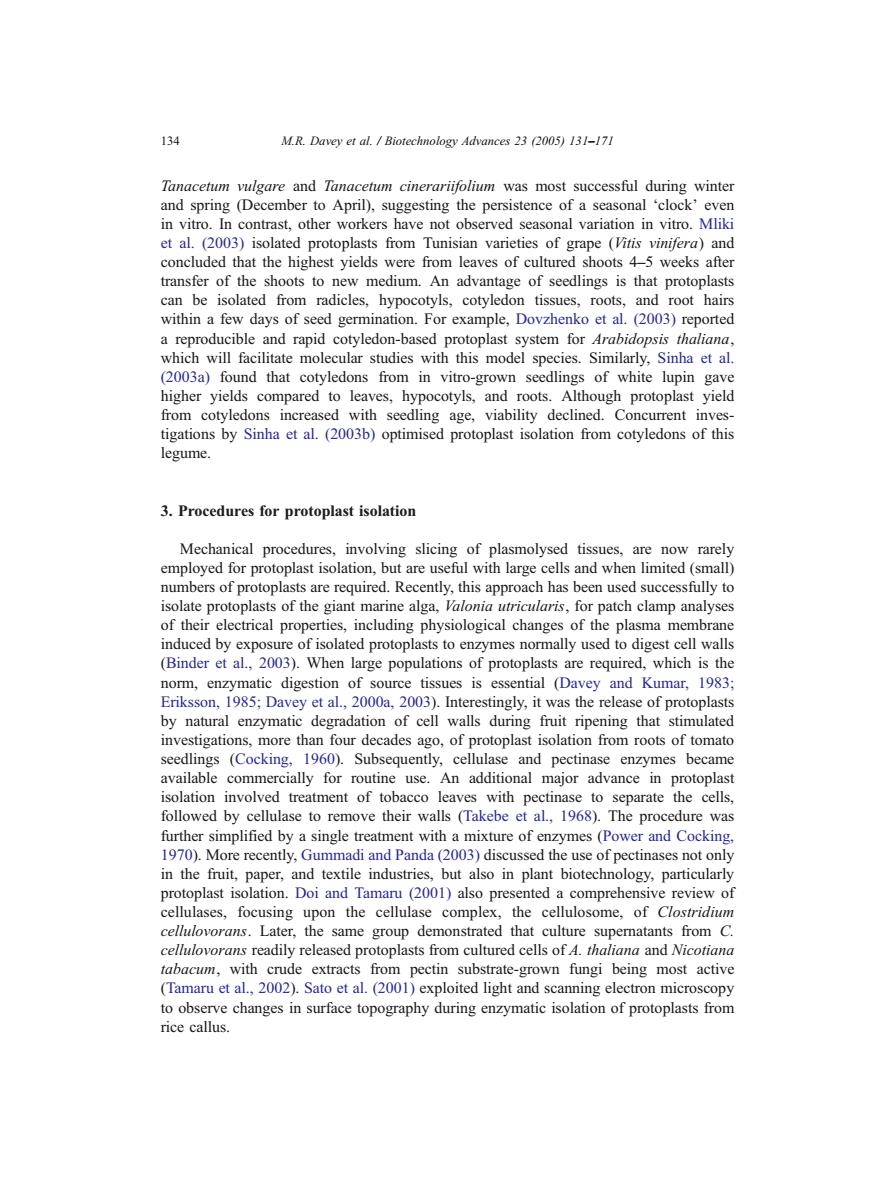正在加载图片...

134 M.R.Davey et al.Biotechnology Advances 23 (2005)131-171 Tanacetum vulgare and Tanacetum cinerariifolium was most successful during winter and spring (December to April),suggesting the persistence of a seasonal 'clock'even in vitro.In contrast.other workers have not observed seasonal variation in vitro.Mliki et al.(2003)isolated protoplasts from Tunisian varieties of grape (Vitis vinifera)and concluded that the highest yields were from leaves of cultured shoots 45 weeks after transfer of the shoots to new medium.An advantage of seedlings is that protoplasts can be isolated from radicles,hypocotyls,cotyledon tissues,roots,and root hairs within a few days of seed germination.For example,Dovzhenko et al.(2003)reported a reproducible and rapid cotyledon-based protoplast system for Arabidopsis thaliana, which will facilitate molecular studies with this model species.Similarly,Sinha et al. (2003a)found that cotyledons from in vitro-grown seedlings of white lupin gave higher yields compared to leaves,hypocotyls,and roots.Although protoplast yield from cotyledons increased with seedling age,viability declined.Concurrent inves- tigations by Sinha et al.(2003b)optimised protoplast isolation from cotyledons of this legume. 3.Procedures for protoplast isolation Mechanical procedures,involving slicing of plasmolysed tissues,are now rarely employed for protoplast isolation,but are useful with large cells and when limited(small) numbers of protoplasts are required.Recently,this approach has been used successfully to isolate protoplasts of the giant marine alga,Valonia utricularis,for patch clamp analyses of their electrical properties,including physiological changes of the plasma membrane induced by exposure of isolated protoplasts to enzymes normally used to digest cell walls (Binder et al.,2003).When large populations of protoplasts are required,which is the norm,enzymatic digestion of source tissues is essential (Davey and Kumar,1983; Eriksson,1985;Davey et al.,2000a,2003).Interestingly,it was the release of protoplasts by natural enzymatic degradation of cell walls during fruit ripening that stimulated investigations,more than four decades ago,of protoplast isolation from roots of tomato seedlings (Cocking,1960).Subsequently,cellulase and pectinase enzymes became available commercially for routine use.An additional major advance in protoplast isolation involved treatment of tobacco leaves with pectinase to separate the cells, followed by cellulase to remove their walls (Takebe et al.,1968).The procedure was further simplified by a single treatment with a mixture of enzymes (Power and Cocking, 1970).More recently,Gummadi and Panda(2003)discussed the use of pectinases not only in the fruit,paper,and textile industries,but also in plant biotechnology,particularly protoplast isolation.Doi and Tamaru (2001)also presented a comprehensive review of cellulases,focusing upon the cellulase complex,the cellulosome,of Clostridium cellulovorans.Later,the same group demonstrated that culture supernatants from C. cellulovorans readily released protoplasts from cultured cells of A.thaliana and Nicotiana tabacum,with crude extracts from pectin substrate-grown fungi being most active (Tamaru et al.,2002).Sato et al.(2001)exploited light and scanning electron microscopy to observe changes in surface topography during enzymatic isolation of protoplasts from rice callus.Tanacetum vulgare and Tanacetum cinerariifolium was most successful during winter and spring (December to April), suggesting the persistence of a seasonal dclockT even in vitro. In contrast, other workers have not observed seasonal variation in vitro. Mliki et al. (2003) isolated protoplasts from Tunisian varieties of grape (Vitis vinifera) and concluded that the highest yields were from leaves of cultured shoots 4–5 weeks after transfer of the shoots to new medium. An advantage of seedlings is that protoplasts can be isolated from radicles, hypocotyls, cotyledon tissues, roots, and root hairs within a few days of seed germination. For example, Dovzhenko et al. (2003) reported a reproducible and rapid cotyledon-based protoplast system for Arabidopsis thaliana, which will facilitate molecular studies with this model species. Similarly, Sinha et al. (2003a) found that cotyledons from in vitro-grown seedlings of white lupin gave higher yields compared to leaves, hypocotyls, and roots. Although protoplast yield from cotyledons increased with seedling age, viability declined. Concurrent investigations by Sinha et al. (2003b) optimised protoplast isolation from cotyledons of this legume. 3. Procedures for protoplast isolation Mechanical procedures, involving slicing of plasmolysed tissues, are now rarely employed for protoplast isolation, but are useful with large cells and when limited (small) numbers of protoplasts are required. Recently, this approach has been used successfully to isolate protoplasts of the giant marine alga, Valonia utricularis, for patch clamp analyses of their electrical properties, including physiological changes of the plasma membrane induced by exposure of isolated protoplasts to enzymes normally used to digest cell walls (Binder et al., 2003). When large populations of protoplasts are required, which is the norm, enzymatic digestion of source tissues is essential (Davey and Kumar, 1983; Eriksson, 1985; Davey et al., 2000a, 2003). Interestingly, it was the release of protoplasts by natural enzymatic degradation of cell walls during fruit ripening that stimulated investigations, more than four decades ago, of protoplast isolation from roots of tomato seedlings (Cocking, 1960). Subsequently, cellulase and pectinase enzymes became available commercially for routine use. An additional major advance in protoplast isolation involved treatment of tobacco leaves with pectinase to separate the cells, followed by cellulase to remove their walls (Takebe et al., 1968). The procedure was further simplified by a single treatment with a mixture of enzymes (Power and Cocking, 1970). More recently, Gummadi and Panda (2003) discussed the use of pectinases not only in the fruit, paper, and textile industries, but also in plant biotechnology, particularly protoplast isolation. Doi and Tamaru (2001) also presented a comprehensive review of cellulases, focusing upon the cellulase complex, the cellulosome, of Clostridium cellulovorans. Later, the same group demonstrated that culture supernatants from C. cellulovorans readily released protoplasts from cultured cells of A. thaliana and Nicotiana tabacum, with crude extracts from pectin substrate-grown fungi being most active (Tamaru et al., 2002). Sato et al. (2001) exploited light and scanning electron microscopy to observe changes in surface topography during enzymatic isolation of protoplasts from rice callus. 134 M.R. Davey et al. / Biotechnology Advances 23 (2005) 131–171